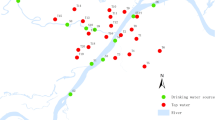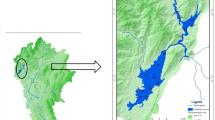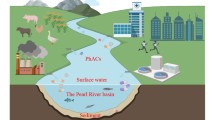Abstract
Bays are transition zones connecting freshwater ecosystems and marine ecosystems, and they are strongly influenced by intensive human activities. Pharmaceuticals are of concern in bay aquatic environments because of their potential threat to marine food web. We studied the occurrence, spatial distribution, and ecological risks of 34 pharmaceutical active compounds (PhACs) in Xiangshan Bay, a heavily industrialized and urbanized area in Zhejiang Province, Eastern China. PhACs were ubiquitously detected in the coastal waters of the study area. A total of twenty-nine compounds were detected in at least one sample. Carbamazepine, lincomycin, diltiazem, propranolol, venlafaxine, anhydro erythromycin, and ofloxacin had the highest detection rate (≥ 93%). These compounds were detected with maximum concentrations of 31, 127, 0.52, 1.96, 2.98, 75, and 98 ng/L, respectively. Human pollution activities included marine aquacultural discharge and effluents from the local sewage treatment plants. These activities were the most influential sources in this study area based on principal component analysis. Lincomycin was an indicator of veterinary pollution of coastal aquatic environment, and the concentrations of lincomycin were positively related to the total phosphorus in this area (r = 0.28, p < 0.05). Typical PhACs such as venlafaxine, ofloxacin, norfloxacin, roxithromycin, and clarithromycin were significantly and positively correlated with nitrate and total nitrogen (r > 0.26, p < 0.05) based on Pearson’s correlation analysis. Carbamazepine was negatively correlated with salinity (r < − 0.30, p < 0.01). Land use pattern was also correlated with the occurrence and distribution of PhACs in the Xiangshan Bay. Some PhACs, i.e., ofloxacin, ciprofloxacin, carbamazepine, and amitriptyline posed medium to high ecological risks to this coastal environment. The results of this study could be helpful to understand the levels of pharmaceuticals, potential sources, and ecological risks in marine aquacultural environment.
Graphical Abstract







Similar content being viewed by others
Data availability
All data generated or analyzed during this study are included in this manuscript and published article.
References
Aguilera MA, Tapia J, Gallardo C, Núñez P, Varas-Belemmi K (2020) Loss of coastal ecosystem spatial connectivity and services by urbanization: natural-to-urban integration for bay management. J Environ Manag 276:111297. https://doi.org/10.1016/j.jenvman.2020.111297
Al-Baldawi IA, Mohammed AA, Mutar ZH, Abdullah SRS, Jasim SS, Almansoory AF, Ismail NI (2021) Application of phytotechnology in alleviating pharmaceuticals and personal care products (PPCPs) in wastewater: source, impacts, treatment, mechanisms, fate, and SWOT analysis. J Clean Prod 319:128584. https://doi.org/10.1016/j.jclepro.2021.128584
Asghar MA, Zhu Q, Sun S, Ye P, Shuai Q (2018) Suspect screening and target quantification of human pharmaceutical residues in the surface water of Wuhan, China, using UHPLC-Q-Orbitrap HRMS. Sci Total Environ 635:828–837. https://doi.org/10.1016/j.scitotenv.2018.04.179
Celic M, Jaen-Gil A, Briceno-Guevara S, Rodriguez-Mozaz S, Gros M, Petrovic M (2021) Extended suspect screening to identify contaminants of emerging concern in riverine and coastal ecosystems and assessment of environmental risks. J Hazard Mater 404:124102. https://doi.org/10.1016/j.jhazmat.2020.124102
Cessna AJ, Kuchta SL, Waiser M, Brua RB, Bailey J (2020) Persistence of the antimicrobials lincomycin, chlortetracycline, and sulfamethazine in prairie wetlands. J Environ Qual 49:236–245. https://doi.org/10.1002/jeq2.20034
Chen H, Liu S, Xu XR, Liu SS, Zhou GJ, Sun KY, Zhao JL, Ying GG (2015a) Antibiotics in typical marine aquaculture farms surrounding Hailing Island, South China: occurrence, bioaccumulation and human dietary exposure. Mar Pollut Bull 90:181–187. https://doi.org/10.1016/j.marpolbul.2014.10.053
Chen YS, Xi XP, Yu G, Cao QM, Wang B, Vince F, Hong YW (2015b) Pharmaceutical compounds in aquatic environment in China: locally screening and environmental risk assessment. Front Environ Sci Eng 9:394–401. https://doi.org/10.1007/s11783-014-0653-1
Daneshvar A, Aboulfadl K, Viglino L, Broseus R, Sauve S, Madoux-Humery A-S, Weyhenmeyer GA, Prevost M (2012) Evaluating pharmaceuticals and caffeine as indicators of fecal contamination in drinking water sources of the Greater Montreal region. Chemosphere 88:131–139. https://doi.org/10.1016/j.chemosphere.2012.03.016
Dehm J, Singh S, Ferreira M, Piovano S, Fick J (2021) Screening of pharmaceuticals in coastal waters of the southern coast of Viti Levu in Fiji, South Pacific. Chemosphere 276:130161. https://doi.org/10.1016/j.chemosphere.2021.130161
Fang TH, Nan FH, Chin TS, Feng HM (2012) The occurrence and distribution of pharmaceutical compounds in the effluents of a major sewage treatment plant in Northern Taiwan and the receiving coastal waters. Mar Pollut Bull 64:1435–1444. https://doi.org/10.1016/j.marpolbul.2012.04.008
Fernández-Rubio J, Rodríguez-Gil JL, Postigo C, Mastroianni N, López de Alda M, Barceló D, Valcárcel Y (2019) Psychoactive pharmaceuticals and illicit drugs in coastal waters of North-Western Spain: environmental exposure and risk assessment. Chemosphere 224:379–389. https://doi.org/10.1016/j.chemosphere.2019.02.041
Ferrey ML, Hamilton MC, Backe WJ, Anderson KE (2018) Pharmaceuticals and other anthropogenic chemicals in atmospheric particulates and precipitation. Sci Total Environ 612:1488–1497. https://doi.org/10.1016/j.scitotenv.2017.06.201
Han QF, Zhao S, Zhang XR, Wang XL, Song C, Wang SG (2020) Distribution, combined pollution and risk assessment of antibiotics in typical marine aquaculture farms surrounding the Yellow Sea, North China. Environ Int 138:105551. https://doi.org/10.1016/j.envint.2020.105551
He Z, Cheng X, Kyzas GZ, Fu J (2016) Pharmaceuticals pollution of aquaculture and its management in China. J Mol Liq 223:781–789. https://doi.org/10.1016/j.molliq.2016.09.005
Hong B, Lin QY, Yu S, Chen YS, Chen YM, Chiang PC (2018) Urbanization gradient of selected pharmaceuticals in surface water at a watershed scale. Sci Total Environ 634:448–458. https://doi.org/10.1016/j.scitotenv.2018.03.392
Jiang L, Hu XL, Yin DQ, Zhang HC, Yu ZY (2011) Occurrence, distribution and seasonal variation of antibiotics in the Huangpu River, Shanghai, China. Chemosphere 82:822–828. https://doi.org/10.1016/j.chemosphere.2010.11.028
Jurasinski G, et al (2018) Understanding the coastal ecocline: assessing sea–land interactions at non-tidal, low-lying coasts through interdisciplinary research. Front Mar Sci 5. https://doi.org/10.3389/fmars.2018.00342
Kallenborn R, Brorstrom-Lunden E, Reiersen LO, Wilson S (2018) Pharmaceuticals and personal care products (PPCPs) in Arctic environments: indicator contaminants for assessing local and remote anthropogenic sources in a pristine ecosystem in change. Environ Sci Pollut Res 25:33001–33013. https://doi.org/10.1007/s11356-017-9726-6
Kemper N (2008) Veterinary antibiotics in the aquatic and terrestrial environment. Ecol Indic 8:1–13. https://doi.org/10.1016/j.ecolind.2007.06.002
Kim HY, Lee IS, Oh JE (2017) Human and veterinary pharmaceuticals in the marine environment including fish farms in Korea. Sci Total Environ 579:940–949. https://doi.org/10.1016/j.scitotenv.2016.10.039
Kolpin DW, Furlong ET, Meyer MT, Thurman EM, Zaugg SD, Barber LB, Buxton HT (2002) Pharmaceuticals, hormones, and other organic wastewater contaminants in U.S. streams, 1999–2000: a national reconnaissance. Environ Sci Technol 36:1202–1211. https://doi.org/10.1021/es011055j
Korkmaz NE, Savun-Hekimoglu B, Aksu A, Burak S, Caglar NB (2022) Occurrence, sources and environmental risk assessment of pharmaceuticals in the Sea of Marmara, Turkey. Sci Total Environ 819:152996. https://doi.org/10.1016/j.scitotenv.2022.152996
Lajeunesse A, Smyth SA, Barclay K, Sauve S, Gagnon C (2012) Distribution of antidepressant residues in wastewater and biosolids following different treatment processes by municipal wastewater treatment plants in Canada. Water Res 46:5600–5612. https://doi.org/10.1016/j.watres.2012.07.042
Li F, Chen L, Chen W, Bao Y, Zheng Y, Huang B, Mu Q, Wen D, Feng C (2020) Antibiotics in coastal water and sediments of the East China Sea: distribution, ecological risk assessment and indicators screening. Mar Poll Bull 151:110810. https://doi.org/10.1016/j.marpolbul.2019.110810
Li F, Wen D, Bao Y, Huang B, Mu Q, Chen L (2022) Insights into the distribution, partitioning and influencing factors of antibiotics concentration and ecological risk in typical bays of the East China Sea. Chemosphere 288:132566. https://doi.org/10.1016/j.chemosphere.2021.132566
Liu S, Wang C, Wang P, Chen J, Wang X, Yuan Q (2020) Anthropogenic disturbances on distribution and sources of pharmaceuticals and personal care products throughout the Jinsha River Basin, China. Environ Res 198:110449. https://doi.org/10.1016/j.envres.2020.110449
Lu Y, Yuan J, Lu X, Su C, Zhang Y, Wang C, Cao X, Li Q, Su J, Ittekkot V, Garbutt RA, Bush S, Fletcher S, Wagey T, Kachur A, Sweijd N (2018) Major threats of pollution and climate change to global coastal ecosystems and enhanced management for sustainability. Environ Pollut 239:670–680. https://doi.org/10.1016/j.envpol.2018.04.016
Mo WY, Chen ZT, Leung HM, Leung AOW (2017) Application of veterinary antibiotics in China’s aquaculture industry and their potential human health risks. Environ Sci Pollut Res 24:8978–8989. https://doi.org/10.1007/s11356-015-5607-z
Nakada N, Kiri K, Shinohara H, Harada A, Kuroda K, Takizawa S, Takada H (2008) Evaluation of pharmaceuticals and personal care products as water-soluble molecular markers of sewage. Environ Sci Technol 42:6347–6353. https://doi.org/10.1021/es7030856
Schultz MM, Furlong ET, Kolpin DW, Werner SL, Schoenfuss HL, Barber LB, Blazer VS, Norris DO, Vajda AM (2010) Antidepressant pharmaceuticals in two U.S. effluent-impacted streams: occurrence and fate in water and sediment, and selective uptake in fish neural tissue. Environ Sci Technol 44:1918–1925. https://doi.org/10.1021/es9022706
Shimizu A, Takada H, Koike T, Takeshita A, Saha M, Rinawati NN, Murata A, Suzuki T, Suzuki S, Chiem NH, Tuyen BC, Viet PH, Siringan MA, Kwan C, Zakaria MP, Reungsang A (2013) Ubiquitous occurrence of sulfonamides in tropical Asian waters. Sci Total Environ 452:108–115. https://doi.org/10.1016/j.scitotenv.2013.02.027
Sun Q, Li Y, Li MY, Ashfaq M, Lv M, Wang HJ, Hu AY, Yu CP (2016) PPCPs in Jiulong River estuary (China): spatiotemporal distributions, fate, and their use as chemical markers of wastewater. Chemosphere 150:596–604. https://doi.org/10.1016/j.chemosphere.2016.02.036
Wang Z, Zhang XH, Huang Y, Wang H (2015) Comprehensive evaluation of pharmaceuticals and personal care products (PPCPs) in typical highly urbanized regions across China. Environ Pollut 204:223–232. https://doi.org/10.1016/j.envpol.2015.04.021
Wang C, Zhao YP, Liu S, Xiao Q, Liang WX, Song YM (2021) Contamination, distribution, and risk assessment of antibiotics in the urban surface water of the Pearl River in Guangzhou, South China. Environ Monit Assess 193. https://doi.org/10.1007/s10661-021-08887-5
Wanjeri VOW, Okuku E, Gachanja A, Ngila JC, Ndungu PG (2023) Occurrence, distribution, and environmental risk of pharmaceutical residues in Mombasa peri-urban creeks, Kenya. Chemosphere 311:137144. https://doi.org/10.1016/j.chemosphere.2022.137144
Wei RC, Ge F, Huang SY, Chen M, Wang R (2011) Occurrence of veterinary antibiotics in animal wastewater and surface water around farms in Jiangsu Province, China. Chemosphere 82:1408–1414. https://doi.org/10.1016/j.chemosphere.2010.11.067
Wilkinson JL et al (2022) Pharmaceutical pollution of the world’s rivers. Proc Natl Acad Sci USA 119:e2113947119. https://doi.org/10.1073/pnas.2113947119
Wu D, Sui Q, Yu X, Zhao W, Li Q, Fatta-Kassinos D, Lyu S (2021) Identification of indicator PPCPs in landfill leachates and livestock wastewaters using multi-residue analysis of 70 PPCPs: analytical method development and application in Yangtze River Delta, China. Sci Total Environ 753:141653. https://doi.org/10.1016/j.scitotenv.2020.141653
Xu M, Huang H, Li N, Li F, Wang D, Luo Q (2019) Occurrence and ecological risk of pharmaceuticals and personal care products (PPCPs) and pesticides in typical surface watersheds, China. Ecotoxicol Environ Saf 175:289–298. https://doi.org/10.1016/j.ecoenv.2019.01.131
Yang M, Qiu W, Chen J, Zhan J, Pan C, Lei X, Wu M (2014) Growth inhibition and coordinated physiological regulation of zebrafish (Danio rerio) embryos upon sublethal exposure to antidepressant amitriptyline. Aquat Toxicol 151:68–76. https://doi.org/10.1016/j.aquatox.2013.12.029
Yang Y-Y, Liu W-R, Liu Y-S, Zhao J-L, Zhang Q-Q, Zhang M, Zhang J-N, Jiang Y-X, Zhang L-J, Ying G-G (2017) Suitability of pharmaceuticals and personal care products (PPCPs) and artificial sweeteners (ASs) as wastewater indicators in the Pearl River Delta, South China. Sci Total Environ 590–591:611–619. https://doi.org/10.1016/j.scitotenv.2017.03.001
Yang L, Zhou Y, Shi B, Meng J, He B, Yang H, Yoon SJ, Kim T, Kwon B-O, Khim JS, Wang T (2020) Anthropogenic impacts on the contamination of pharmaceuticals and personal care products (PPCPs) in the coastal environments of the Yellow and Bohai seas. Environ Int 135:105306. https://doi.org/10.1016/j.envint.2019.105306
Yi XZ, Lin CH, Ong EJL, Wang M, Zhou Z (2019) Occurrence and distribution of trace levels of antibiotics in surface waters and soils driven by non-point source pollution and anthropogenic pressure. Chemosphere 216:213–223. https://doi.org/10.1016/j.chemosphere.2018.10.087
Yu X, Sui Q, Lyu SG, Zhao WT, Liu JG, Cai ZX, Yu G, Barcelo D (2020) Municipal solid waste landfills: an underestimated source of pharmaceutical and personal care products in the water environment. Environ Sci Technol 54:9757–9768. https://doi.org/10.1021/acs.est.0c00565
Zhang NS, Liu YS, Van den Brink PJ, Price OR, Ying GG (2015) Ecological risks of home and personal care products in the riverine environment of a rural region in South China without domestic wastewater treatment facilities. Ecotoxicol Environ Saf 122:417–425. https://doi.org/10.1016/j.ecoenv.2015.09.004
Zhang P, Zhou H, Li K, Zhao X, Liu Q, Li D, Zhao G, Wang L (2018a) Occurrence of pharmaceuticals and personal care products, and their associated environmental risks in Guanting Reservoir and its upstream rivers in north China. RSC Adv 8:4703–4712. https://doi.org/10.1039/C7RA12945A
Zhang R, Pei J, Zhang R, Wang S, Zeng W, Huang D, Wang Y, Zhang Y, Wang Y, Yu K (2018b) Occurrence and distribution of antibiotics in mariculture farms, estuaries and the coast of the Beibu Gulf, China: bioconcentration and diet safety of seafood. Ecotoxicol Environ Saf 154:27–35. https://doi.org/10.1016/j.ecoenv.2018.02.006
Zhao S, Liu X, Cheng D, Liu G, Liang B, Cui B, Bai J (2016) Temporal–spatial variation and partitioning prediction of antibiotics in surface water and sediments from the intertidal zones of the Yellow River Delta, China. Sci Total Environ 569–570:1350–1358. https://doi.org/10.1016/j.scitotenv.2016.06.216
Zhao F, Chen L-D, Yen H, Li G, Sun L, Yang L (2019) An innovative modeling approach of linking land use patterns with soil antibiotic contamination in peri-urban areas. Environ Int 134:105327. https://doi.org/10.1016/j.envint.2019.105327
Zhao F, Chen L-D, Yang L, Sun L, Li S, Li M, Feng Q (2020) Effects of land use and rainfall on sequestration of veterinary antibiotics in soils at the hillslope scale. Environ Pollut 260:114112. https://doi.org/10.1016/j.envpol.2020.114112
Zou S, Xu W, Zhang R, Tang J, Chen Y, Zhang G (2011) Occurrence and distribution of antibiotics in coastal water of the Bohai Bay, China: impacts of river discharge and aquaculture activities. Environ Pollut 159:2913–2920. https://doi.org/10.1016/j.envpol.2011.04.037
Funding
This work was supported by the National Natural Science Foundation of China (No. 31971489).
Author information
Authors and Affiliations
Contributions
Tang Jianfeng contributed to the study conception and design. Material preparation and data collection and analysis were performed by Sun Jing, Ke Ziyan, Zhang Yujie, Wu Qin, and Chen Yihua. The first draft of the manuscript was written by Sun Jing, and all authors commented on previous versions of the manuscript. All authors read and approved the final manuscript.
Corresponding author
Ethics declarations
Ethics approval and consent to participate
No animal or human parts were used in this study. All the authors are giving our ethical approval and consent for this paper to be published in your journal if found publishable.
Consent for publication
All the authors have read and approved this manuscript and take responsibility for its contents. The participant has consented to the submission of the manuscript to the journal.
Competing interest
The authors declare no competing interests.
Additional information
Responsible Editor: Hongwen Sun
Publisher's note
Springer Nature remains neutral with regard to jurisdictional claims in published maps and institutional affiliations.
Highlights
Pharmaceutical active compounds were ubiquitous in the urbanized area in the Xiangshan Bay.
Lincomycin could be defined as an indicator of aquacultural pollution in the coastal aquatic environment.
Effluents from local sewage treatment plants should not be ignored when we evaluated the potential sources of pharmaceuticals in the urbanized bay used for marine aquaculture.
Amitriptyline had the highest ecological risk in the urbanized bay.
Supplementary Information
Below is the link to the electronic supplementary material.
Rights and permissions
Springer Nature or its licensor (e.g. a society or other partner) holds exclusive rights to this article under a publishing agreement with the author(s) or other rightsholder(s); author self-archiving of the accepted manuscript version of this article is solely governed by the terms of such publishing agreement and applicable law.
About this article
Cite this article
Sun, J., Ke, Z., Zhang, Y. et al. Pharmaceutical active compounds in a heavily industrialized and urbanized bay, Eastern China. Environ Sci Pollut Res 30, 51624–51637 (2023). https://doi.org/10.1007/s11356-023-26019-z
Received:
Accepted:
Published:
Issue Date:
DOI: https://doi.org/10.1007/s11356-023-26019-z




